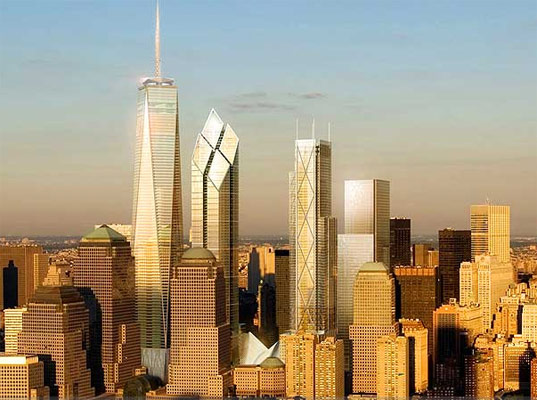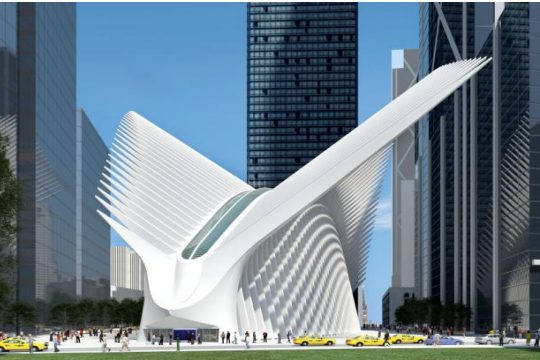The New World Trade Center: A Design Opportunity Lost
Evan Moffitt
12/7/2011


During a brief visit to New York, I had the chance to visit the recently unveiled September 11th Memorial. The two huge pools, elegant scars of the fallen World Trade Center towers, have a graceful simplicity that recalls Maya Lin (Lin was, in fact, on the committee that reviewed design submissions for the Memorial). Although slightly smaller in size than the original towers, the two pools are the largest manmade waterfalls in North America. Beneath the names of the victims of the 9/11 attacks etched in bronze, glassy water pours past dark granite walls to a square, central drain.
The 9/11 Memorial’s design has been mostly well received. Yet it is only the first unveiling of a nearly 10-step project—the renovation of the entire World Trade Center site, a plan involving the construction of five new skyscrapers, 550,000 feet of retail space, a performing arts center, and a new transportation hub for Lower Manhattan. The design for these buildings has been constantly altered and “watered down” over the years. Architects have come and gone, leaving behind designs for single buildings that, when completed, will have difficulty living together in close quarters.
Daniel Liebeskind, the original winner of the WTC design competition, proposed a jagged and striking plan for the space. The plan featured a single high-rise ascending above Manhattan’s skyline, several neighboring towers, a central station to house the Port Authority (separately designed by Spanish architect Santiago Calatrava), and a subterranean museum. Much of the original site is covered by open park space. This far in the construction process, the WTC design has Liebeskind’s physical layout—but its buildings have gone milquetoast. One World Trade Center, or Freedom Tower, is rising quickly above 80 floors, will stop at 105. A 408-foot spire will bring the tower to a symbolic 1,776 foot height—making it the tallest building in North America. The design, by David Childs, abandoned Liebeskind’s striking angles in favor of a simple rectilinear tower, laced by diagonal support beams, atop a 200 foot tall concrete base. The tower is covered in shimmering reflective glass. Originally, the glass was supposed to cover the entire building; now, due to cost, the concrete base remains bare. Like a bunker, the base was designed to withstand virtually every kind of attack. Its hulking size and solid weight are offensive and offer little light into the interior space.
Instead of transforming the scarred landscape of the World Trade Center into an inviting and innovative space, the final designs for the site are bland versions of what could have been. I worry that ten years later, we’ll visit the WTC and wonder if it hadn’t been built before the attacks occurred. As a building that will dominate New York’s skyline, Freedom Tower ought to press boundaries, to move both the city and urban design into the future. As a building that lies on hallowed ground in the American mind, it ought to reflect on the pain of 9/11 while inspiring and uplifting all who see it. Childs’ design falls flat. The most unique and inspiring building, the Port Authority transportation hub designed by Calatrava, has undergone significant design alterations due to whopping costs. Topped by massive steel ribs shipped from Spain, the building was designed to resemble a “soaring bird”, according to Calatrava. The bird metaphor was an appropriate choice for a site risen from the ashes of tragedy like a phoenix. But with Calatrava’s design already costing $3.2 billion, the bird has become a stegosaurus. Instead of wing-like ribs, the building’s ribs stand straight up along its spine-like roofline. Altered so significantly, Calatrava’s ground-breaking design will give the Port Authority a Mohawk. And Liebeskind’s only remaining solid design, the 9/11 Memorial Museum, is an incongruous splinter of steel in odd company. All together, the World Trade Center site recalls not the tragedy of 9/11 and the promise of the future, but an opportunity for architectural progress carelessly lost.


